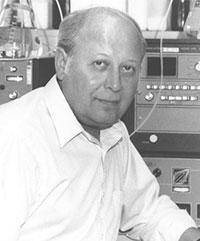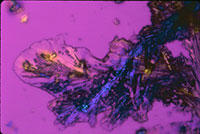Key Points
- Cisplatin, a chemotherapy drug, is best known for curing testicular cancer.
- Prior to the discovery of cisplatin, men with testicular cancer had few medical options.
- Cisplatin is also used in the treatment of a wide range of other cancers, including lung, bladder, cervical, and ovarian cancers.
- Cisplatin and other similar platinum-based drugs were developed with National Cancer Institute (NCI) support. They are prescribed for an estimated 10 to 20 percent of all cancer patients.
Pathway to Discovery
In the experiment that led to the discovery of cisplatin in 1965, Barnett Rosenberg, Ph.D., was following a hunch. Dr. Rosenberg, a biophysics researcher at Michigan State University (MSU), had noticed that microscopic images of dividing cells resembled the pattern of iron shavings subjected to a magnetic field. He wondered whether this meant that an electrical field could also affect cell division, so he devised an experiment to find out.
An "accidental" discovery leads to cisplatin. Because platinum was thought to have no biological activity, Dr. Rosenberg and his colleagues put platinum electrodes into a solution containing the common laboratory bacteria E. coli and turned on the power. As soon as the current started, the bacterial cells stopped dividing, although they kept growing to up to 300 times their normal length. When the power was cut off, the bacterial cells began dividing again. It appeared that the electrical field was controlling cell division. Dr. Rosenberg later called this experiment the "accidental discovery that led eventually to cisplatin."
However, Dr. Rosenberg and his colleagues did not yet know what they had discovered. They thought they might have found a way to control cell growth with electrical currents. They spent two years trying to discover why the electrical field had such a profound effect. Finally, they realized that electricity had nothing to do with it. Cell division was being blocked not by the electric field, but by a platinum compound released from the electrodes. After another two years, Dr. Rosenberg's team identified the compound that affected cell division so dramatically. It was later named cisplatin.
Researchers use cisplatin to control cancer cell division and expansion. Dr. Rosenberg then wondered whether cisplatin would also block cell division in tumors. Testing it in a sarcoma mouse model, he and his colleagues found that it did indeed attack tumors. While cisplatin was highly toxic—for example, causing kidney damage when used at a high dose—the mice were able to tolerate the drug in low doses. More importantly, the tumors responded to cisplatin and shrank. Six months later, the mice remained healthy and showed no return of the tumors.
Enhancing Cancer Care
At first, the cancer research community was skeptical about cisplatin. Heavy metals were considered poisons, and "the idea of putting a heavy metal into a person was an abomination," Dr. Rosenberg recalled. Officials at NCI, however, were impressed with these findings and continued to fund this research. The anticancer effects were confirmed in extensive testing across many other types of tumors.
Based on positive results, NCI began funding clinical trials of cisplatin in human cancer patients in 1972, including trials of patients with advanced testicular cancer led by Lawrence Einhorn, M.D., of Indiana University. The successful results of these trials led to Food and Drug Administration (FDA) approval of cisplatin in 1978 for testicular cancer treatment. "It was a monumental discovery," says Bruce Chabner, M.D., former director of NCI's Division of Cancer Treatment and now director of clinical research at the Massachusetts General Hospital Cancer Center. Cisplatin was also approved by the FDA for the treatment of advanced ovarian and bladder cancer in 1978.
Cisplatin helps save lives from testicular cancer. In particular, cisplatin's success as a chemotherapy drug against testicular cancer is phenomenal. When used in combination with other chemotherapy drugs, its cure rate is more than 90 percent. The U.S. death rate from testicular cancer has dropped by two-thirds since 1975. It is estimated that nearly 9,000 American men will be diagnosed with testicular cancer and approximately 400 will die from the disease in 2017.
Cisplatin plays a key role in fighting multiple cancer types. Less dramatically but far more broadly, cisplatin "became the backbone of combination therapy" for a wide range of solid tumors, according to Dr. Chabner. These include bladder, cervical, ovarian, lung, gastric, breast, and head and neck cancers, along with malignant mesothelioma and some less-common tumors. Chabner noted that "the patients cured by these regimens and those that have benefited from this therapy number in the millions. It would be frightening to imagine the current status of cancer treatment without this essential drug".
Turning Discovery into Health
Cisplatin was first approved in the United States for clinical use to treat cancer in 1978 and research is actively ongoing. Thousands of cisplatin analogs have been developed and researchers are still trying to produce new ones to reduce toxic side effects, to tailor the drug to particular forms of cancer, and combat drug resistance. Some of the analogs created include carboplatin (which is gentler on patients), oxaliplatin (which is particularly effective against colon cancer), and satraplatin (which can be taken orally).
Cisplatin is also stimulating research on DNA repair processes in cancer cells, as some important questions still need to be answered. For example, what makes cancer cells susceptible to drugs that damage DNA? How do they develop resistance to platinum? Do they increase their ability to repair DNA damage; and if so, how do they achieve this?
Cancer cells typically have defects in their DNA repair mechanisms. Dr. Chabner says that "some of these defects sensitize them to agents like platinum, and we're trying to understand how that happens". On the other hand, different cancer cells become resistant to platinum treatment in different ways over time. Researchers are also trying to figure out how and why that happens.
Research to Practice: NCI's Role
NCI-funded research has aimed at developing cisplatin-based treatments and creating similar platinum-based drugs that would be less toxic and/or easier for patients to tolerate. This research is ongoing. NCI also teamed with Bristol-Myers (now Bristol-Myers-Squibb), to which cisplatin was licensed, to sponsor the clinical trials that led to FDA approval.
Key Takeaway
Cisplatin, a chemotherapy drug, is best known for curing testicular cancer. It is also used in the treatment of a wide range of other cancers, including lung, bladder, cervical, and ovarian cancers. Cisplatin and other similar platinum-based drugs were developed with National Cancer Institute (NCI) support. Ongoing research has aimed at developing cisplatin-based treatments and creating similar platinum-based drugs that would be less toxic and/or easier for patients to tolerate.
Selected Resources
Chabner B. Barnett Rosenberg: In memoriam (1924-2009). Cancer Res. 2010;70;428-429.
Kelland L. The resurgence of platinum-based chemotherapy. Nat Rev Cancer. 2007;7:573-584. [PubMed Abstract]
National Cancer Institute. Cisplatin. Contains brief information about cisplatin and provides links to more information about the use of this drug, research results, and ongoing clinical trials.
Rosenberg B, Van Camp L. The successful regression of large solid sarcoma 180 tumors by platinum compounds. Cancer Res. 1970;30:1799-1802.

